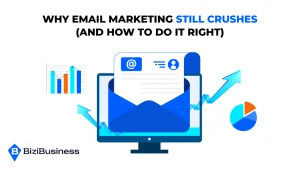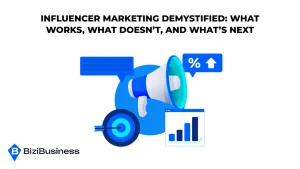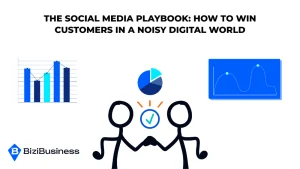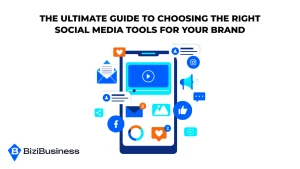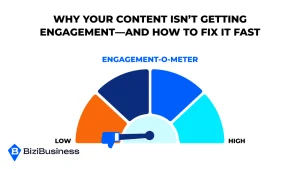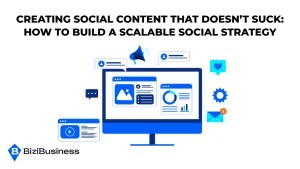BiziTopics
Workflows That Work: The Science Behind Email Automation That Converts
BiziBusiness
Aug 12, 2025
13 min read
If you’re still sending manual emails to every new subscriber or writing one-off broadcasts for every promo, you’re not just wasting time—you’re leaving money on the table.
Manual email marketing doesn’t scale. It burns bandwidth, delays revenue, and makes you rely on luck instead of logic. Smart email automation, on the other hand, creates leverage. It lets you build once, personalize infinitely, and sell 24/7—without chasing every click in real time.
Done right, automation powers:
- Seamless onboarding experiences
- Timely, behavior-triggered offers
- Consistent re-engagement and retention
- Higher lifetime value with less churn
This guide will walk you through both the science and the systems behind workflows that truly convert. From foundational sequences to advanced logic, you’ll learn how to automate with purpose—and turn your inbox into a revenue engine.
The Psychology Behind High-Converting Email Workflows
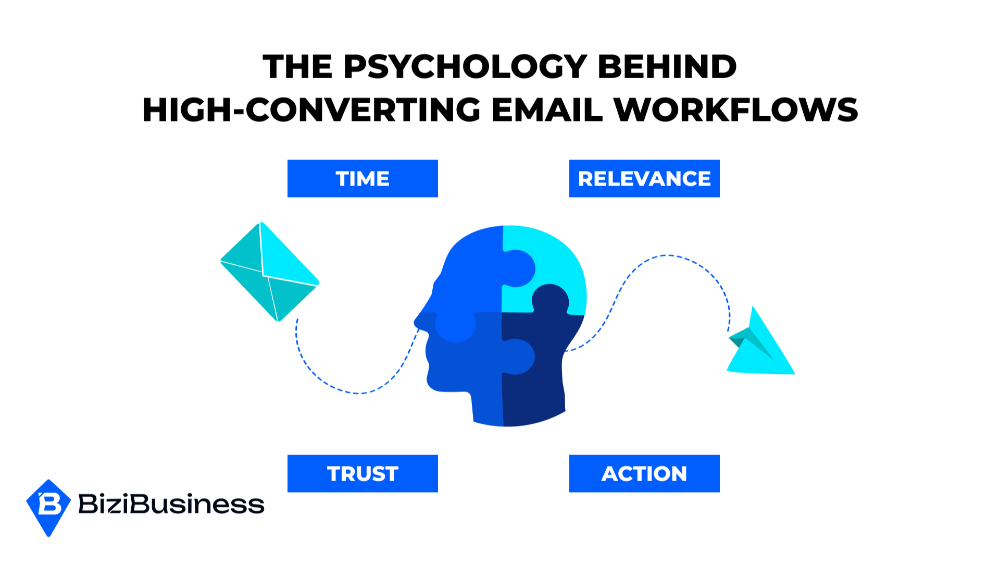
At the heart of every successful email workflow is a simple truth: people take action when the timing is right and the message is relevant. That’s why automation—done right—consistently outperforms manual campaigns.
Timing + Relevance = Trust and Action
Humans are creatures of context. An offer that feels intrusive today might feel like a godsend tomorrow—if it lands at the right moment.
Automated workflows capitalize on this by syncing email delivery to real-time behavior, not random batch schedules. Whether it’s a welcome series delivered within seconds of signup or a follow-up offer triggered after a product view, automation makes your emails feel timely, helpful, and natural.
That sense of relevance builds trust—and trust fuels action.
Micro-Conversions Create Momentum
Big wins don’t come from one big email. They come from a sequence of small, strategic nudges: downloading a resource, clicking a testimonial, visiting a product page. These micro-conversions reveal intent—and automation lets you respond accordingly.
Behavior-based workflows adjust messaging, timing, and offers in response to these micro-signals, keeping the journey fluid, personal, and aligned with the subscriber’s state of mind.
Why Automation Outperforms One-Off Campaigns
Manual email campaigns sends treat your list building like a monolith. Everyone gets the same message, regardless of interest, timing, or behavior.
Automation flips that. It delivers the right message to the right person at the right time, based on what they’ve done—or haven’t done—yet. That’s why:
- Automated emails have 70.5% higher open rates
- Triggered emails get 152% more click-throughs than regular newsletters
- Automated sequences generate 2x–3x more revenue per message
With automation, every email campaigns becomes part of a conversation—not just another blast.
Core Automation Workflows Every Business Needs
You don’t need dozens of flows to get serious results. You need a few high-impact automations, done right. These aren’t just marketing nice-to-haves—they’re your frontline tools for building trust, recovering sales, and maximizing customer lifetime value.
Here are the five foundational workflows every business should have in place:
1. Welcome Series – Build Trust & Set Expectations
Your welcome flow is your first impression—and your best shot at turning a curious subscriber into an engaged lead. It should:
- Deliver the lead magnet (if applicable)
- Introduce your brand voice and mission
- Set expectations for future emails
- Tease your most valuable resources or offers
- End with a CTA that nudges toward a small win (like a product quiz or content click)
This is where the relationship starts. Make it count.
2. Lead Nurture – Educate, Build Desire, and Segment
Not everyone is ready to buy right away. A nurture flow keeps leads warm by:
- Addressing pain points
- Teaching key concepts
- Sharing proof (case studies, testimonials)
- Soft-segmenting based on behavior or interest
- Positioning your product as the logical next step
It’s less about pitching and more about priming—so when they are ready, they think of you.
3. Abandoned Cart – Recover Lost Revenue
Shoppers abandon carts for all kinds of reasons—distractions, uncertainty, or simple hesitation. A timely, well-crafted abandoned cart sequence can recover 10–20% of those lost sales.
Your cart flow should:
- Remind them what they left behind
- Reassure (with FAQs or testimonials)
- Offer a time-sensitive incentive (if appropriate)
- Include urgency in the final reminder
Time it smart: typically 1 hour, 24 hours, and 48–72 hours post-abandonment.
4. Re-engagement – Wake Up the Sleeping List
Over time, subscribers go quiet. But that doesn’t mean they’re lost—yet.
Re-engagement workflows:
- Remind them what they signed up for
- Ask for feedback or preferences
- Offer exclusive content or incentives
- Give a clear “stay or go” option
Anyone who doesn’t engage after this? Suppress or sunset. It protects your deliverability and keeps your list building lean.
5. Post-Purchase – Build Loyalty, Upsell, and Get Reviews
The sale isn’t the end—it’s the beginning of a long-term customer relationship.
A strong post-purchase sequence:
- Thanks the customer and sets usage expectations
- Offers tips, how-tos, or content that enhances product experience
- Introduces complementary products
- Collects reviews, referrals, or feedback
When you keep delivering value post-sale, you turn customers into repeat buyers and brand advocates.
Planning Your Workflow Like A Funnel (Not A Broadcast)
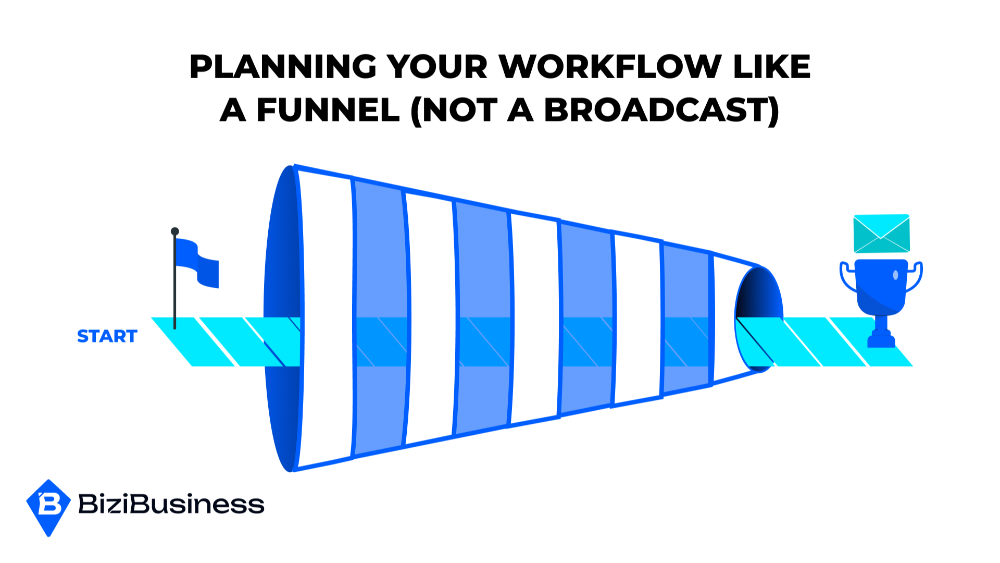
Most email design workflows fail for one reason: they’re treated like broadcasts, not funnels. A good automation sequence doesn’t just send a series of emails—it guides a prospect toward a clear action, step by step.
That starts with purpose-built design and decision logic—not guesswork.
Start With the End in Mind
Before building any automation, define the single primary goal of the sequence. What action should the subscriber take by the end?
- For a welcome series, it might be: “Click to explore our product line”
- For lead nurture: “Book a discovery call”
- For a cart abandonment flow: “Complete their purchase”
- For post-purchase: “Leave a review or reorder”
Once you know the goal, every email in the sequence can support it—one micro-conversion at a time.
Map the Journey, Not Just the Emails
Think of your workflow like a decision tree, not a line of dominoes. Map how subscribers enter, what actions they might take, and how the journey adapts.
Ask:
- What’s the entry point (quiz, opt-in form, product view)?
- What do we send first, and what’s the expected next action?
- If they click → what happens next?
- If they don’t engage → do we try again, or change the message?
This mapping ensures that each step logically flows toward conversion, not confusion.
Use Triggers and Segmentation to Stay Relevant
Not all subscribers are at the same stage—or want the same thing. Use behavioral triggers (opens, clicks, time delays, tags) to create personalized pathways.
Example:
- If a lead clicks a case study, trigger a product-specific follow-up
- If someone ignores a sales email, trigger a lighter, story-driven email
- If a user makes a purchase, exit them from sales and enter post-purchase
These micro-adjustments make the experience feel tailored—and that translates into trust, engagement, and action.
Anatomy Of A High-Converting Automated Email

Automation doesn’t mean “generic.” In fact, your automated emails should be more compelling than your broadcasts—because they land at critical moments in your customer’s journey.
To get results, each email in your workflow must combine attention-grabbing subject lines, empathetic copy, and clear calls to action—delivered at just the right pace.
Subject Lines That Get the Open
The subject line is your first (and sometimes only) shot at getting noticed in a crowded inbox. High-converting lines:
- Tap into curiosity: “Forgot this in your cart?” or “3 things you’re missing out on”
- Use urgency sparingly: “Offer ends tonight” or “24 hours left to claim this”
- Personalize meaningfully: Use names, locations, or specific behaviors (e.g., “Still thinking about the Starter Plan?”)
- Avoid spam triggers: All caps, too many exclamations, or misleading promises
Test relentlessly—and pair with compelling preview text to maximize opens.
Copy That Connects and Converts
Automation should never sound automated. Great workflow emails are:
- Conversational: Write like a person, not a brand. Use short sentences, contractions, and natural phrasing.
- Focused: One idea per email. Don’t overwhelm—build momentum.
- Benefit-driven: Highlight what’s in it for them, not what you’re excited about.
- Story-backed: Use micro-narratives, testimonials, or mini case studies to prove your point without being pushy.
Think of each email as a page in a short story—pulling your reader toward action with every scroll.
Call to Action: Clear, Singular, and Timed Right
Every automated email should have one clear CTA—not a buffet of links. Whether it’s “Book a call,” “Watch the demo,” or “Complete your order,” the ask should be obvious and easy.
Best practices:
- Use buttons over hyperlinks (they convert higher)
- Repeat the CTA once above the fold and once at the end
- Use urgency or incentive when appropriate (but sparingly to avoid fatigue)
Email Pacing: Don’t Rush, Don’t Stall
Email timing can make or break your flow. Set delays based on:
- Behavioral context: Cart abandonment should be fast (1 hour); nurture sequences can be spaced out (2–3 days)
- Engagement signals: If someone clicks early, fast-track them to the next step
- Email frequency tolerance: New leads might welcome daily emails; long-time subscribers may prefer 1–2 per week
Pace each sequence to build momentum, not fatigue your list building.
Choosing The Right Automation Tools (And Setting Them Up Right)
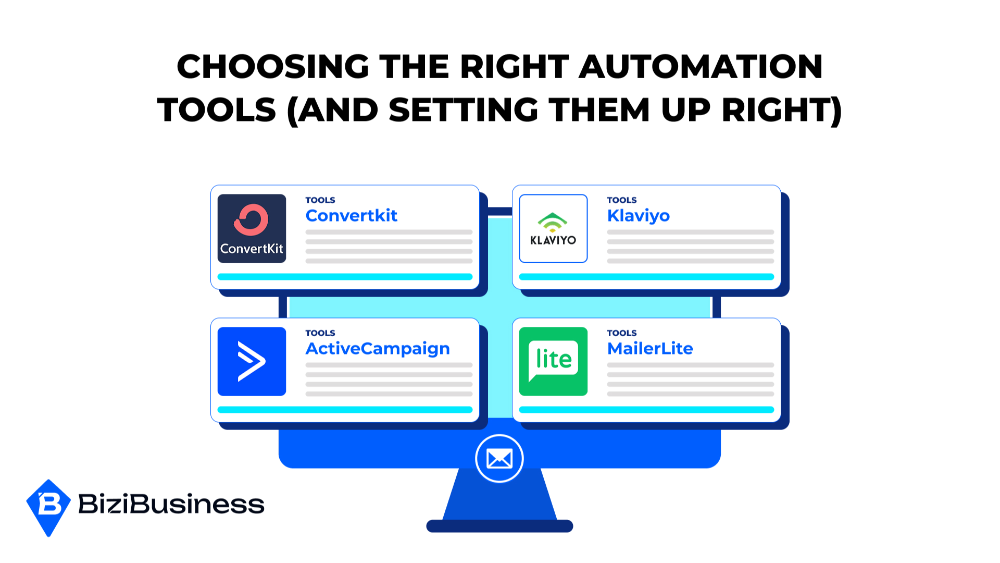
A smart automation strategy needs a smart platform behind it. But with so many tools on the market, choosing the right one—and setting it up the right way—can feel overwhelming.
The good news? Most businesses don’t need dozens of bells and whistles. What you need is a tool that fits your goals, team size, and tech stack—with room to grow.
Top Automation Platforms Compared
Here’s a quick breakdown of the most trusted tools on the market:
| Tool | Best For | Strengths | Considerations |
|---|---|---|---|
| ConvertKit | Solo creators, coaches, small teams | Simple UI, great for lead magnets & tags | Basic reporting; less robust for ecommerce |
| Klaviyo | Ecommerce brands | Deep Shopify integration, product-based automation | Overkill for non-retail businesses |
| ActiveCampaign | Growth-stage B2B and service brands | Powerful automation logic, CRM features | Steeper learning curve |
| MailerLite | Budget-conscious beginners | Clean interface, good for startups | Limited advanced triggers and integrations |
No one-size-fits-all. Choose based on what you’ll actually use, not what sounds cool.
Must-Have Features for Workflow Success
Regardless of platform, make sure your tool includes:
- Visual automation builder: Drag-and-drop logic to design flows clearly
- Tagging and segmentation: For behavior-based personalization
- A/B testing: For subject lines, content, and timing
- Ecommerce or CRM integration: To sync customer data in real time
- Deliverability controls: For managing sender reputation and list hygiene
Without these, scaling becomes clunky—and results get fuzzy.
Setup Pitfalls (and How to Avoid Them)
- Skipping foundational flows: Many businesses jump straight into fancy segmentation before building a proper welcome or post-purchase sequence.
- Over-complicating the logic: Don’t build a flow you can’t explain in one sentence. Start simple, then optimize.
- Ignoring data hygiene: Set rules for suppressing inactive contacts, and always test new automations with internal or test accounts before going live.
- Using default templates without customization: Branded voice and user-centric messaging are essential—even in automation.
The best tools aren’t the most expensive—they’re the ones that make execution easier and growth more predictable. Choose thoughtfully. Set up intentionally.
Test, Track And Tweak For Maximum ROI
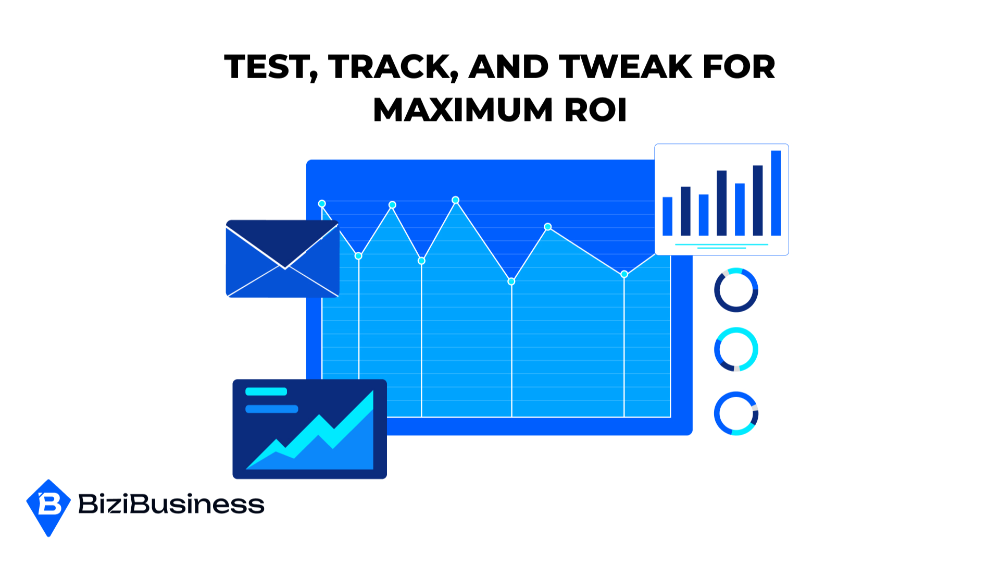
Automation isn’t a “set-it-and-forget-it” solution—it’s a system that thrives on iteration. Once your workflows are live, the real work begins: measuring performance, testing ideas, and optimizing based on behavior.
Why? Because even the best-planned sequences can underperform without refinement. The difference between mediocre and high-ROI automation is what you do after launch.
Track What Actually Matters
While open rates can be a directional signal, they’ve become less reliable due to privacy updates. Focus on the metrics that impact your bottom line:
- Click-Through Rate (CTR): A clear measure of engagement and content relevance
- Conversion Rate: Tracks actual action—purchases, bookings, downloads
- Revenue Per Email (RPE): The ultimate KPI for sales-focused workflows
- Unsubscribe/Complaint Rate: A warning sign for poor targeting or cadence issues
These tell you what’s working and what’s losing you money.
Run Smart A/B Tests Inside Workflows
Workflows aren’t static—they’re testing labs. Use A/B testing to optimize:
- Subject lines (question vs. statement, short vs. long)
- Email timing (1 hour vs. 12 hours post-behavior)
- Message content (story-driven vs. direct response)
- CTA placement or language (button above vs. below, “Buy Now” vs. “Get Yours”)
Even a 1–2% bump in click or conversion rates can translate to significant revenue over time.
Tweak Timing and Cadence Based on Real Behavior
Timing should feel natural, not mechanical. If your audience:
- Clicks early, consider accelerating their sequence
- Goes cold, space out emails or offer a re-engagement option
- Converts mid-sequence, exit them to avoid overselling
Many tools allow behavior-based branching or goal completion exits. Use them to ensure automation feels like a conversation, not a megaphone.
Scaling Your Automation As Your Business Grows
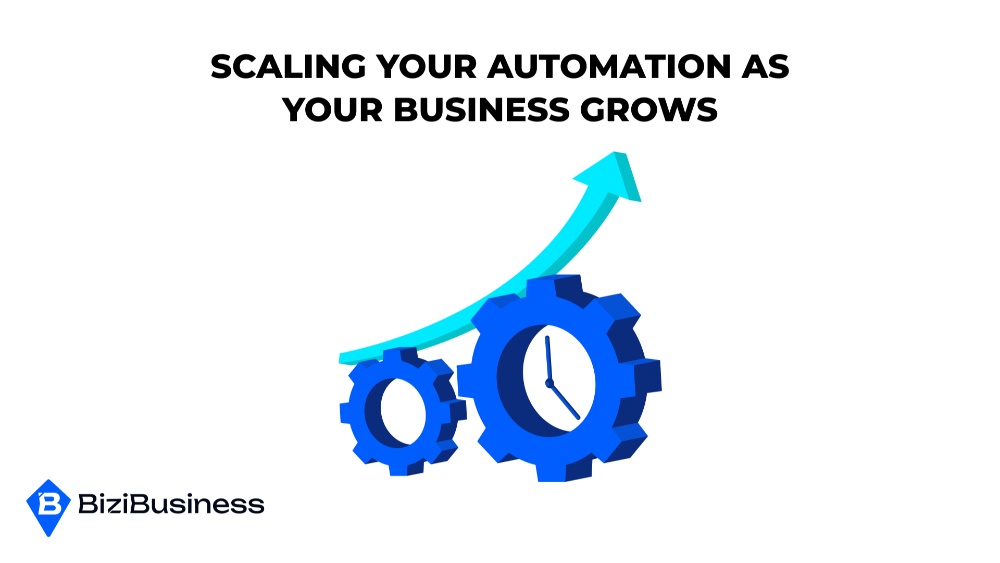
Once your core workflows are in place and optimized, the next step is scaling with sophistication. As your list grows, your sales cycle evolves, and your tech stack matures, so should your automation strategy.
Scaling isn’t about adding more emails. It’s about building a system that feels personal—even as your volume increases.
Know When to Build vs. Optimize
If your existing workflows are consistently underperforming, fix the leaks before expanding. But if they’re delivering on key KPIs, look for strategic gaps like:
- Missing mid-funnel education flows
- No engagement triggers for repeat buyers
- Lack of onboarding for new customers or trial users
- Weak re-engagement for aging segments
Add new workflows when there’s a new opportunity or audience segment to serve—not just for the sake of doing more.
Integrate Automation Into Your Full Funnel
As your tech stack matures, email should work hand-in-hand with your CRM, website, and ad platforms. Think beyond the inbox:
- Trigger emails from pipeline activity (e.g., “lead status changed”)
- Sync custom fields for hyper-specific segmentation
- Retarget inactive subscribers via ads using email behavior data
- Use CRM deal stages to move contacts in and out of automation
This creates a closed-loop system that maximizes every touchpoint across your funnel.
Use Zero-Party Data and Dynamic Content at Scale
As privacy rules evolve, relying on tracking pixels and 3rd-party data isn’t enough. The new gold standard? Zero-party data—information your audience voluntarily shares.
Collect it via:
- Quizzes and onboarding surveys
- Preference centers
- Post-purchase feedback forms
Then, plug it into your automations using dynamic content blocks. Show different copy, offers, or resources based on:
- Job role or industry
- Purchase history
- Funnel stage
- Survey answers
This makes your emails feel tailored at scale—and that’s where trust, engagement, and conversion skyrocket.
Final Word: Automation Is the Engine — Strategy Is the Fuel
Automation can transform your marketing. But without strategy, it’s just noise on autopilot.
Let’s recap what actually drives results:
- Start with psychology: Timed, behavior-based emails feel relevant and drive action.
- Build core workflows: Welcome, nurture, cart recovery, re-engagement, and post-purchase should be non-negotiables.
- Plan like a funnel: Every sequence needs a goal, a journey, and logic to match user intent.
- Design with purpose: Subject lines, copy, and pacing matter more in automation than anywhere else.
- Choose the right tools: Simplicity, segmentation, and data access beat flashy features.
- Test and evolve: The best systems get better with every send.
- Scale smart: Integrate your CRM, leverage data, and personalize without limits.
But here’s the catch: automation is never “set it and forget it.” It’s a living, breathing growth engine—and it needs strategic fuel to keep performing.
If your current workflows are underwhelming or underused, now’s the time to fix that.
Subscribe to Newsletter
Unlock your creativity and stay up to date on marketing tips
